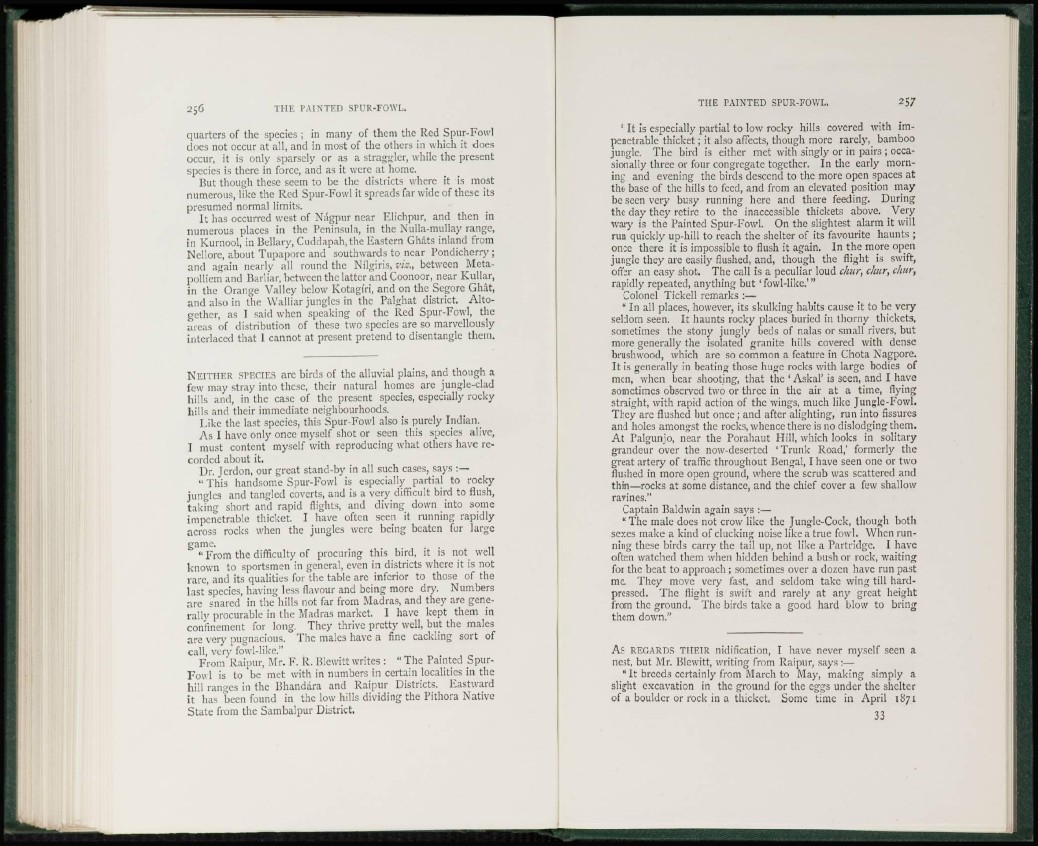
quarters of the species ; in many of them the Red Spur-Fowl
does not occur at all, and in most of the others in which it does
occur, it is only sparsely or as a straggler, while the present
species is there in force, and as it were at home.
But though these seem to be the districts where it is most
numerous, like the Red Spur-Fowl it spreads far wide of these its
presumed normal limits.
I t has occurred west of Nagpur near Elichpur, and then in
numerous places in the Peninsula, in the Nulla-mullay range,
in Kurnool, in Bellary, Cuddapah, the Eastern Ghats inland from
Ncllorc, about Tupapore and southwards to near Pondicherry ;
and again nearly all round the Nilgiris, vis., between Metapolliem
and Barliar, between the latter and Coonoor, near Kullar,
in the Orange Valley below Kotagiri, and on the Segore Ghat,
and also in the Walliar jungles in the Palghat district. Altogether,
as I said when speaking of the Red Spur-Fowl, the
areas of distribution of these two species are so marvellously
interlaced that I cannot at present pretend to disentangle them.
NEITHER SPECIES arc birds of the alluvial plains, and though a
few may stray into these, their natural homes are jungle-clad
hills and, in the case of the present species, especially rocky
hills and their immediate neighbourhoods.
Like the last species, this Spur-Fowl also is purely Indian.
As I have only once myself shot or seen this species alive,
I must content myself with reproducing what others have recorded
about it.
Dr. Jcrdon, our great stand-by in all such cases, says :—
" This handsome Spur-Fowl is especially partial to rocky
jungles and tangled coverts, and is a very difficult bird to flush,
taking short and rapid flights, and diving down into some
impenetrable thicket. I have often seen it running rapidly
across rocks when the jungles were being beaten for large
game.
" From the difficulty of procuring this bird, it is not well
known to sportsmen in general, even in districts where it is not
rare, and its qualities for the table are inferior to those of the
last species, having less flavour and being more dry. Numbers
are snared in the hills not far from Madras, and they are generally
procurable in the Madras market. I have kept them in
confinement for long. They thrive pretty well, but the males
are very pugnacious. The males have a fine cackling sort of
call, very fowl-like."
From Raipur, Mr. F. R. Blcwitt writes : " The Painted Spur-
Fow 1 is to be met with in numbers in certain localities in the
hill ranges in the Bhandara and Raipur Districts. Eastward
it has been found in the low hills dividing the Pithora Native
State from the Sambalpur District.
" It is especially partial to low rocky hills covered with impenetrable
thicket; it also affects, though more rarely, bamboo
jungle. The bird is either met with singly or in pairs ; occasionally
three or four congregate together. In the early morning
and evening the birds descend to the more open spaces at
the base of the hills to feed, and from an elevated position may
be seen very busy running here and there feeding. During
the day they retire to the inaccessible thickets above. Very
wary is the Painted Spur-Fowl. On the slightest alarm it will
run quickly up-hill to reach the shelter of its favourite haunts ;
once there it is impossible to flush it again. In the more open
jungle they are easily flushed, and, though the flight is swift,
offer an easy shot. The call is a peculiar loud chur, chur, chur,
rapidly repeated, anything b u t ' fowl-like.'"
Colonel Tickell remarks :—
" In all places, however, its skulking habits cause it to be very
seldom seen. It haunts rocky places buried in thorny thickets,
sometimes the stony jungly beds of nalas or small rivers, but
more generally the isolated granite hills covered with dense
brushwood, which are so common a feature in Chota Nagpore.
It is generally in beating those huge rocks with large bodies of
men, when bear shooting, that the ' Askal' is seen, and I have
sometimes observed two or three in the air at a time, flying
straight, with rapid action of the wings, much like Jungle-Fowl.
They are flushed but once ; and after alighting, run into fissures
and holes amongst the rocks, whence there is no dislodging them.
At Palgunjo, near the Porahaut Hill, which looks in solitary
grandeur over the now-deserted 'Trunk Road,' formerly the
great artery of traffic throughout Bengal, I have seen one or two
flushed in more open ground, where the scrub was scattered and
thin—rocks at some distance, and the chief cover a few shallow
ravines."
Captain Baldwin again says :—
" The male does not crow like the Jungle-Cock, though both
sexes make a kind of clucking noise like a true fowl. When running
these birds carry the tail up, not like a Partridge. I have
often watched them when hidden behind a bush or rock, waiting
for the beat to approach ; sometimes over a dozen have run past
me. They move very fast, and seldom take wing till hardpressed.
The flight is swift and rarely at any great height
from the ground. The birds take a good hard blow to bring
them down."
As REGARDS THEIR nidification, I have never myself seen a
nest, but Mr. Blewitt, writing from Raipur, says :—
" It breeds certainly from March to May, making simply a
slight excavation in the ground for the eggs under the shelter
of a boulder or rock in a thicket. Some time in April 1871